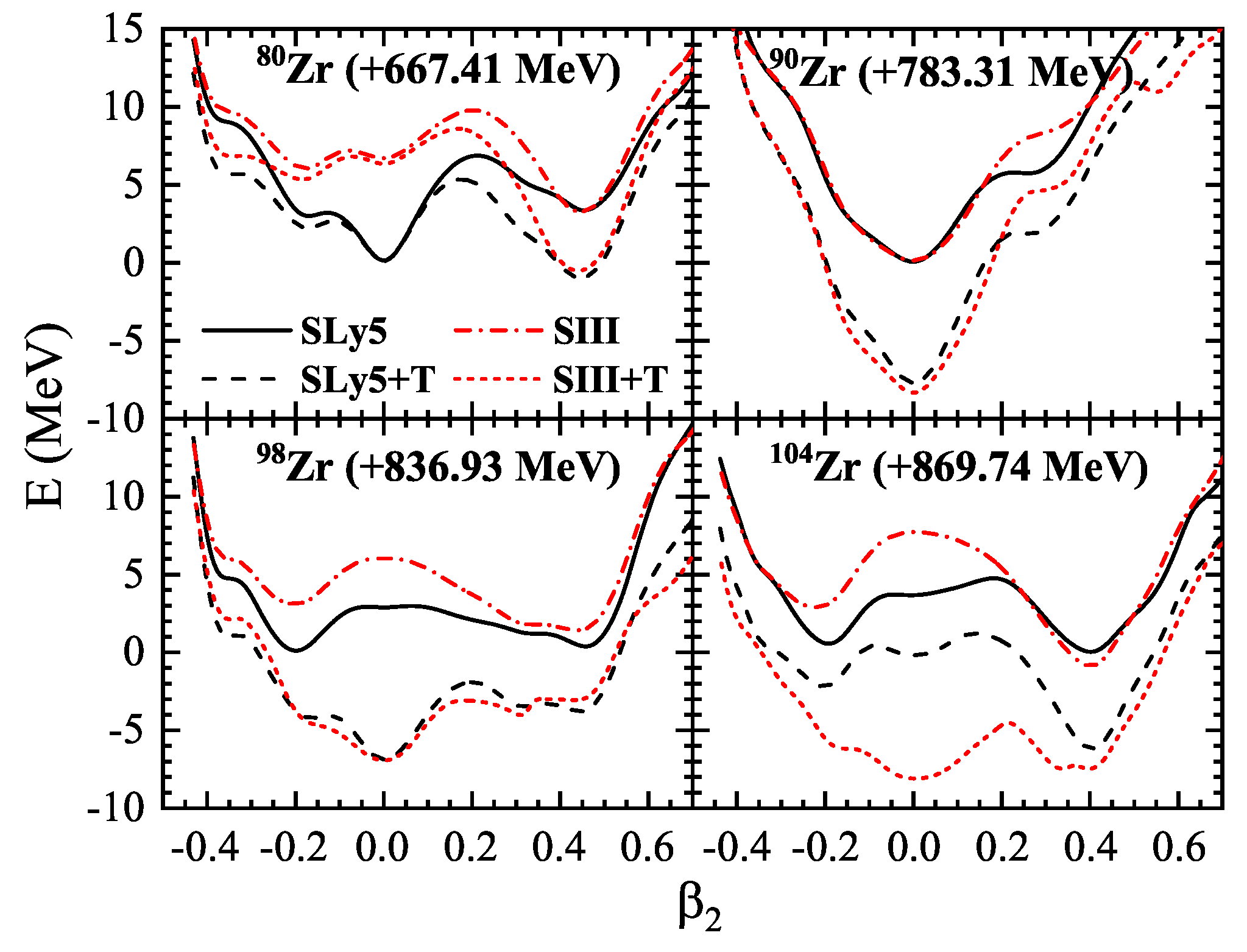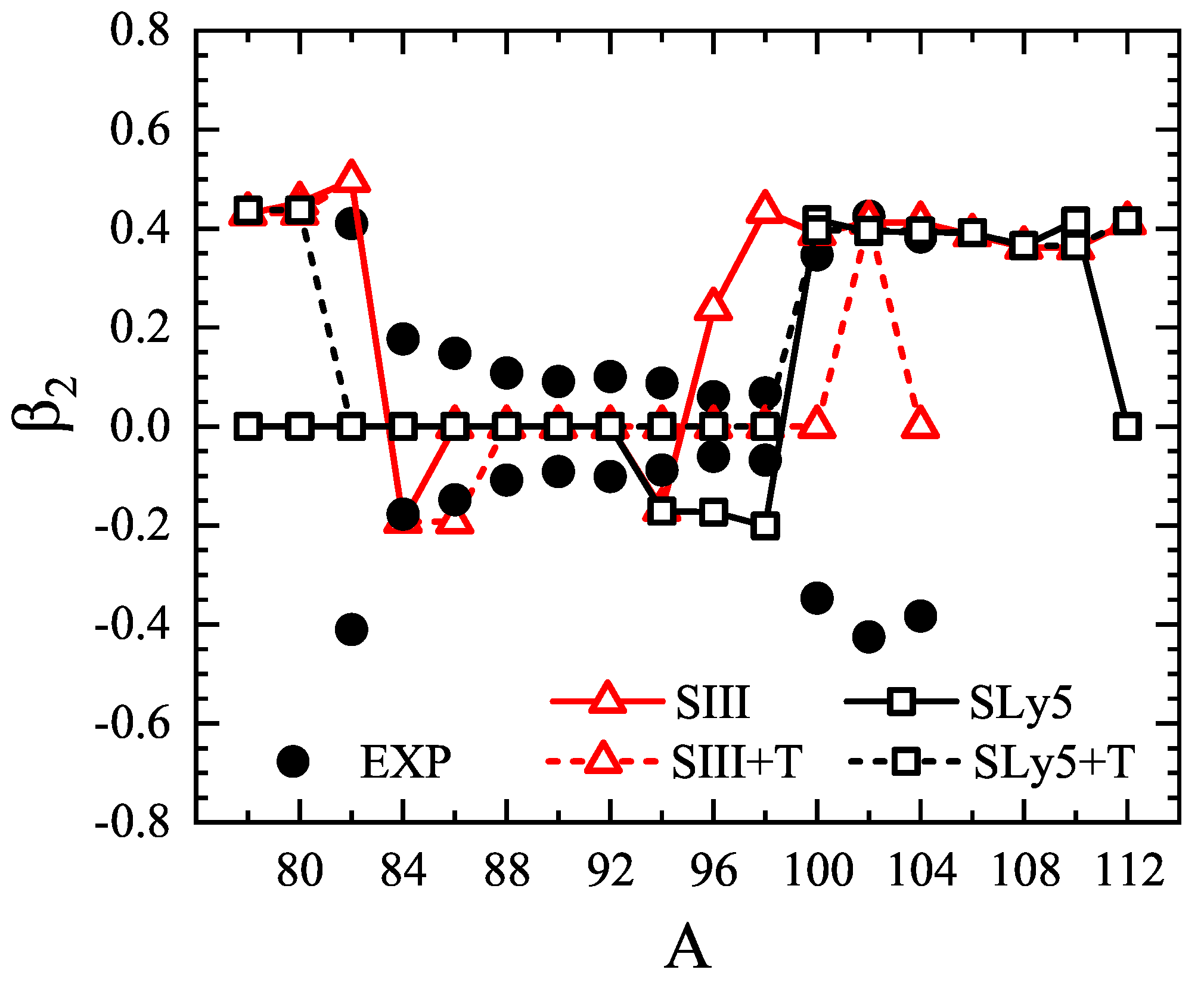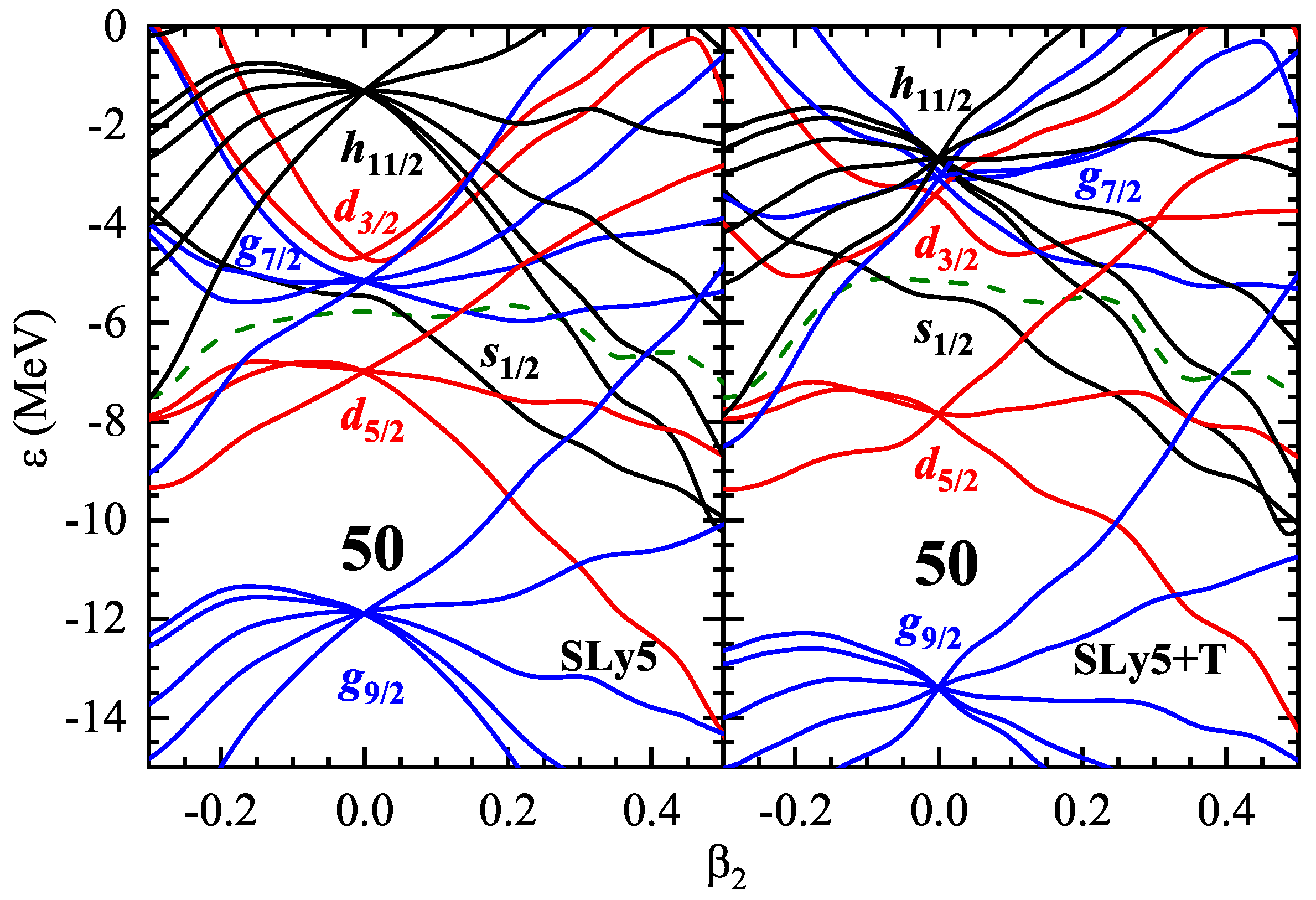Effects of the Tensor Force on the Ground Properties of Zr Isotopes
Abstract
:1. Introduction
2. Theoretical Framework
3. Results and Discussion
4. Summary
Author Contributions
Funding
Institutional Review Board Statement
Informed Consent Statement
Data Availability Statement
Acknowledgments
Conflicts of Interest
References
- Yukawa, H. On the Theory of Elementary Particles. I*. Prog. Theor. Phys. 1947, 2, 209–215. [Google Scholar] [CrossRef]
- Bender, M.; Heenen, P.H.; Reinhard, P.G. Self-consistent mean-field models for nuclear structure. Rev. Mod. Phys. 2003, 75, 121–180. [Google Scholar] [CrossRef]
- Otsuka, T.; Suzuki, T.; Fujimoto, R.; Grawe, H.; Akaishi, Y. Evolution of Nuclear Shells due to the Tensor Force. Phys. Rev. Lett. 2005, 95, 232502. [Google Scholar] [CrossRef] [Green Version]
- Skyrme, T. The spin-orbit interaction in nuclei. Nucl. Phys. 1958, 9, 635–640. [Google Scholar] [CrossRef]
- Vautherin, D.; Brink, D.M. Hartree–Fock Calculations with Skyrme’s Interaction. I. Spherical Nuclei. Phys. Rev. C 1972, 5, 626–647. [Google Scholar] [CrossRef]
- Brown, B.A.; Duguet, T.; Otsuka, T.; Abe, D.; Suzuki, T. Tensor interaction contributions to single-particle energies. Phys. Rev. C 2006, 74, 061303. [Google Scholar] [CrossRef] [Green Version]
- Lesinski, T.; Bender, M.; Bennaceur, K.; Duguet, T.; Meyer, J. Tensor part of the Skyrme energy density functional: Spherical nuclei. Phys. Rev. C 2007, 76, 014312. [Google Scholar] [CrossRef] [Green Version]
- Zalewski, M.; Dobaczewski, J.; Satuła, W.; Werner, T.R. Spin-orbit and tensor mean-field effects on spin-orbit splitting including self-consistent core polarizations. Phys. Rev. C 2008, 77, 024316. [Google Scholar] [CrossRef] [Green Version]
- Shen, S.; Colò, G.; Roca-Maza, X. Skyrme functional with tensor terms from ab initio calculations of neutron-proton drops. Phys. Rev. C 2019, 99, 034322. [Google Scholar] [CrossRef] [Green Version]
- Otsuka, T.; Matsuo, T.; Abe, D. Mean Field with Tensor Force and Shell Structure of Exotic Nuclei. Phys. Rev. Lett. 2006, 97, 162501. [Google Scholar] [CrossRef] [Green Version]
- Nakada, H. Properties of exotic nuclei and their linkage to the nucleonic interaction. Int. J. Mod. Phys. E 2020, 29, 1930008. [Google Scholar] [CrossRef] [Green Version]
- Colo‘, G.; Sagawa, H.; Fracasso, S.; Bortignon, P. Spin–orbit splitting and the tensor component of the Skyrme interaction. Phys. Lett. B 2007, 646, 227–231. [Google Scholar] [CrossRef] [Green Version]
- Brink, D.M.; Stancu, F. Evolution of nuclear shells with the Skyrme density dependent interaction. Phys. Rev. C 2007, 75, 064311. [Google Scholar] [CrossRef] [Green Version]
- Miyahara, S.; Nakada, H. Shape evolution of Zr nuclei and roles of the tensor force. Phys. Rev. C 2018, 98, 064318. [Google Scholar] [CrossRef] [Green Version]
- Blazkiewicz, A.; Oberacker, V.E.; Umar, A.S.; Stoitsov, M. Coordinate space Hartree–Fock-Bogoliubov calculations for the zirconium isotope chain up to the two-neutron drip line. Phys. Rev. C 2005, 71, 054321. [Google Scholar] [CrossRef] [Green Version]
- Abusara, H.; Ahmad, S. Shape evolution in Kr, Zr, and Sr isotopic chains in covariant density functional theory. Phys. Rev. C 2017, 96, 064303. [Google Scholar] [CrossRef]
- Vautherin, D. Hartree–Fock Calculations with Skyrme’s Interaction. II. Axially Deformed Nuclei. Phys. Rev. C 1973, 7, 296–316. [Google Scholar] [CrossRef]
- Chabanat, E.; Bonche, P.; Haensel, P.; Meyer, J.; Schaeffer, R. A Skyrme parametrization from subnuclear to neutron star densities Part II. Nuclei far from stabilities. Nucl. Phys. A 1998, 635, 231–256. [Google Scholar] [CrossRef]
- Beiner, M.; Flocard, H.; Van Giai, N.; Quentin, P. Nuclear ground-state properties and self-consistent calculations with the skyrme interaction: (I). Spherical description. Nucl. Phys. A 1975, 238, 29–69. [Google Scholar] [CrossRef]
- Stancu, F.; Brink, D.; Flocard, H. The tensor part of Skyrme’s interaction. Phys. Lett. B 1977, 68, 108–112. [Google Scholar] [CrossRef] [Green Version]
- Zhou, X.R.; Schulze, H.J.; Sagawa, H.; Wu, C.X.; Zhao, E.G. Hypernuclei in the deformed Skyrme–Hartree–Fock approach. Phys. Rev. C 2007, 76, 034312. [Google Scholar] [CrossRef]
- Fracasso, S.; Colò, G. Fully self-consistent charge-exchange quasiparticle random-phase approximation and its application to isobaric analog resonances. Phys. Rev. C 2005, 72, 064310. [Google Scholar] [CrossRef] [Green Version]
- Blum, V.; Lauritsch, G.; Maruhn, J.; Reinhard, P.G. Comparison of coordinate-space techniques in nuclear mean-field calculations. J. Comput. Phys. 1992, 100, 364–376. [Google Scholar] [CrossRef]
- Kinsey, R.R. The NUDAT/PCNUDAT Program for Nuclear Data, Paper Submitted to the 9th International Symposium of Capture Gamma-ray Spectroscopy and Related Topics, Budapest, Hungary, October 1996. Data Extracted from the NUDAT Database, Version (3.0). Available online: https://www.nndc.bnl.gov/nudat3/ (accessed on 9 November 2021).
- Togashi, T.; Tsunoda, Y.; Otsuka, T.; Shimizu, N. Quantum Phase Transition in the Shape of Zr isotopes. Phys. Rev. Lett. 2016, 117, 172502. [Google Scholar] [CrossRef] [PubMed]
- García-Ramos, J.E.; Heyde, K. Subtle connection between shape coexistence and quantum phase transition: The Zr case. Phys. Rev. C 2020, 102, 054333. [Google Scholar] [CrossRef]




| A | EXP | SIII | SIII + T | ΔET (MeV) | Δβ2T | SLy5 | SLy5 + T | ΔET (MeV) | Δβ2T | |||||
|---|---|---|---|---|---|---|---|---|---|---|---|---|---|---|
| E (MeV) | |β2| | E (MeV) | β2 | E (MeV) | β2 | E (MeV) | β2 | E (MeV) | β2 | |||||
| 78 | −639.132 | −636.427 | 0.430 | −639.855 | 0.431 | 3.428 | −0.001 | −637.427 | 0.000 | −640.661 | 0.437 | 3.234 | −0.437 | |
| 80 | −669.800 | −664.182 | 0.452 | −667.957 | 0.431 | 3.775 | 0.021 | −667.414 | 0.000 | −668.419 | 0.438 | 1.005 | −0.438 | |
| 82 | −694.130 | 0.410 | − | 0.497 | −692.171 | 0.497 | 3.824 | 0.000 | −692.851 | 0.000 | −693.300 | 0.000 | 0.449 | 0.000 |
| 84 | −718.116 | 0.177 | −712.633 | −0.191 | −715.485 | −0.192 | 2.852 | 0.001 | −716.920 | 0.000 | −718.363 | 0.000 | 1.443 | 0.000 |
| 86 | −740.804 | 0.148 | −736.827 | 0.000 | −740.734 | −0.193 | 3.907 | 0.193 | −739.946 | 0.000 | −742.914 | 0.000 | 2.968 | 0.000 |
| 88 | −762.608 | 0.108 | −760.372 | 0.000 | −766.122 | 0.000 | 5.750 | 0.000 | −762.058 | 0.000 | −767.126 | 0.000 | 5.068 | 0.000 |
| 90 | −783.810 | 0.091 | −783.208 | 0.000 | −791.750 | 0.000 | 8.542 | 0.000 | −783.312 | 0.000 | −791.125 | 0.000 | 7.813 | 0.000 |
| 92 | −799.664 | 0.101 | −795.625 | 0.000 | −805.141 | 0.000 | 9.516 | 0.000 | −796.824 | 0.000 | −805.279 | 0.000 | 8.455 | 0.000 |
| 94 | −814.604 | 0.088 | −808.942 | −0.167 | −818.705 | 0.000 | 9.763 | −0.167 | −810.369 | −0.171 | −819.428 | 0.000 | 9.059 | −0.171 |
| 96 | −828.672 | 0.060 | −821.753 | 0.238 | −832.329 | 0.000 | 10.576 | 0.238 | −823.883 | −0.173 | −833.578 | 0.000 | 9.695 | −0.173 |
| 98 | −840.938 | 0.068 | −835.513 | 0.435 | −843.911 | 0.000 | 8.398 | 0.435 | −836.928 | −0.201 | −843.916 | 0.000 | 6.988 | −0.201 |
| 100 | −852.215 | 0.347 | −848.815 | 0.390 | −855.218 | 0.000 | 6.403 | 0.390 | −848.504 | 0.418 | −853.926 | 0.397 | 5.422 | 0.021 |
| 102 | −863.532 | 0.425 | −860.238 | 0.413 | −867.362 | 0.414 | 7.124 | −0.001 | −859.642 | 0.394 | −865.111 | 0.396 | 5.469 | −0.002 |
| 104 | −873.808 | 0.383 | −870.635 | 0.412 | −877.852 | 0.000 | 7.217 | 0.412 | −869.736 | 0.393 | −875.940 | 0.395 | 6.204 | −0.002 |
| 106 | −882.768 | −879.727 | 0.387 | −879.096 | 0.391 | −884.576 | 0.392 | 5.480 | −0.001 | |||||
| 108 | −891.756 | −888.413 | 0.362 | −887.900 | 0.365 | −892.488 | 0.366 | 4.588 | −0.001 | |||||
| 110 | −899.470 | −896.550 | 0.361 | −894.903 | 0.415 | −900.218 | 0.365 | 5.315 | 0.050 | |||||
| 112 | −906.528 | −902.629 | 0.412 | −901.789 | 0.000 | −907.003 | 0.416 | 5.214 | −0.416 | |||||
Publisher’s Note: MDPI stays neutral with regard to jurisdictional claims in published maps and institutional affiliations. |
© 2021 by the authors. Licensee MDPI, Basel, Switzerland. This article is an open access article distributed under the terms and conditions of the Creative Commons Attribution (CC BY) license (https://creativecommons.org/licenses/by/4.0/).
Share and Cite
Chen, C.-F.; Chen, Q.-B.; Zhou, X.-R.; Cheng, Y.-Y. Effects of the Tensor Force on the Ground Properties of Zr Isotopes. Symmetry 2021, 13, 2193. https://doi.org/10.3390/sym13112193
Chen C-F, Chen Q-B, Zhou X-R, Cheng Y-Y. Effects of the Tensor Force on the Ground Properties of Zr Isotopes. Symmetry. 2021; 13(11):2193. https://doi.org/10.3390/sym13112193
Chicago/Turabian StyleChen, Chao-Feng, Qi-Bo Chen, Xian-Rong Zhou, and Yi-Yuan Cheng. 2021. "Effects of the Tensor Force on the Ground Properties of Zr Isotopes" Symmetry 13, no. 11: 2193. https://doi.org/10.3390/sym13112193
APA StyleChen, C.-F., Chen, Q.-B., Zhou, X.-R., & Cheng, Y.-Y. (2021). Effects of the Tensor Force on the Ground Properties of Zr Isotopes. Symmetry, 13(11), 2193. https://doi.org/10.3390/sym13112193






